
UC Berkeley's Harry Kreisler interviews historian and activist Howard Zinn. (2001) (42 min)
- Subject:
- Arts and Humanities
- History
- U.S. History
- Material Type:
- Lecture
- Provider:
- UCTV Teacher's Pet
- Date Added:
- 04/21/2005

UC Berkeley's Harry Kreisler interviews historian and activist Howard Zinn. (2001) (42 min)
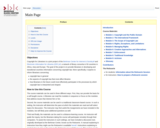
This open education online course is designed for librarians to gain a basic understanding in copyright, international copyright issues, licensing, and it even contains a module on traditional knowledge and activism.
The modules on activism and traditional knowledge make this resource a bit unique and useful as an add-on to any "traditional" copyright training modules.

A century before the Civil Rights movement, this small town on Lake Michigan had racially integrated schools, churches, government, and civic organizations. Settled by black and white pioneers in the mid-1800s, Covert Township worked across racial and ethnic lines at a time when doing so was widely rejected if not outright illegal. Learn the story of this remarkable community, told against the backdrop of Reconstruction’s overthrow in the South and worsening racial conflict in the North.
When much of America was tearing itself apart and squandering the moral victories of the Civil War, this community nestled in the west Michigan wilderness came together — not as a utopian social experiment, but as ordinary people who relied on one another to solve the problems of ordinary life on the frontier, and whose legacy endures today in Covert and beyond. This little-known American story offers an example our country needs now more than ever.
The Woodson Center's Black History and Excellence curriculum is based on the Woodson Principles and tells the stories of Black Americans whose tenacity and resilience enabled them to overcome adversity and make invaluable contributions to our country. It also teaches character and decision-making skills that equip students to take charge of their futures. These lessons in Black American excellence are free and publicly available for all.

A century before the Civil Rights movement, this small town on Lake Michigan had racially integrated schools, churches, government, and civic organizations. Settled by Black and White pioneers in the mid-1800s, Covert Township worked across racial and ethnic lines at a time when doing so was widely rejected if not outright illegal. Learn the story of this remarkable community, told against the backdrop of Reconstruction’s overthrow in the South and worsening racial conflict in the North.When much of America was tearing itself apart and squandering the moral victories of the Civil War, this community nestled in the west Michigan wilderness came together — not as a utopian social experiment, but as ordinary people who relied on one another to solve the problems of ordinary life on the frontier, and whose legacy endures today in Covert and beyond. This little-known American story offers an example our country needs now more than ever.The Woodson Center's Black History and Excellence curriculum is based on the Woodson Principles and tells the stories of Black Americans whose tenacity and resilience enabled them to overcome adversity and make invaluable contributions to our country. It also teaches character and decision-making skills that equip students to take charge of their futures. These lessons in Black American excellence are free and publicly available for all.

Throughout this unit students will be able to gain an understanding of the importance of protecting the environment. This will be done through a series of mini projects that will focus on the various facets of the environment from a variety of lenses. This unit will change the focus from the personal level to a more global level.

Throughout this unit students will be able to gain an understanding of the importance of protecting the environment. This will be done through a series of mini projects that will focus on the various facets of the environment from a variety of lenses. This unit will change the focus from the personal level to a more global level.
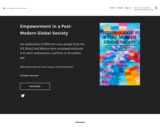
An exploration of different ways people from the US, Brazil and Mexico have reclaimed authority over their communities and lives in the global age.

This zine is comprised of four main sections: (1) a history of natural resource inequalities in NYC and the goals of environmental justice; (2) the importance of effective waste management with ways to reduce waste in your community; (3) a breakdown of legislative influence and how to get involved in local politics to further environmental justice; and (4) a collection of environmental groups and resources across NYC. An online version of this resource exists at ourcityplanetfuture.wordpress.com. That site also has a link to a printable version of the zine.

This lesson will cover the story of the Tape family, Chinese immigrants and their American-born children residing in San Francisco, California. Joseph and Mary Tape attempted to enroll their daughter, Mamie, at Spring Valley Primary, an all-white school, and were denied based on their race. Students will learn about the Tape family, Joseph and Mary’s California Supreme Court case, Tape v. Hurley (1885), and the greater connections their story lent itself to anti-Asian sentiment in the United States at that time and fight for school desegregation.
2021 Social Science Standards Integrated with Ethnic Studies:
Civics and Government: 7.5, 8.2, 8.6, 8.7, 8.8, HS.1, HS.2
Geography: HS.51
Historical Knowledge: 8.22, 8.25, HS.52, HS.58, HS.64, HS.65, HS.66
Historical Thinking: 7.25, 8.31, 8.32, HS.67, HS.68, HS.69
Social Science Analysis: 8.34, 8.36, HS.72, HS.73, HS.74

This course examines the definition of gender in scientific, societal, and historical contexts. It explores how gender influences state formation and the work of the state, what role gender plays in imperialism and in the welfare state, the ever-present relationship between gender and war, and different states’ regulation of the body in gendered ways at different times. It also investigates new directions in the study of gender as historians, anthropologists and others have taken on this fascinating set of problems. Students taking the graduate version complete additional assignments.

During the 1970s, arts and culture became vehicles for elevating the narratives of Asian Americans, a term first used in 1968 during the struggle to establish ethnic studies at San Francisco State College. Under this new pan-Asian identity, a generation of young Asian American organizers, academics, and artists emerged and ready to define themselves and their history to the rest of America. Musicians, artists, writers and filmmakers helped to increase the visibility of Asian American identities and cultures across various media.
Civics and Government: HS.11
Historical Knowledge: 8.25, HS.63, HS.65
Historical Thinking: 8.32
Social Science Analysis: 6.24, 7.28
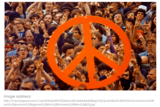
The 1960s and 70s comprised some of the most tumultuous eras in American history. The people were using their voices to express dissatisfaction with their government. This lesson provides a brief history of America’s involvement in Vietnam and surrounding areas. The focal point of the lesson is the resistance on the American homefront. In this lesson, you will discover first-hand how men were drafted for the Vietnam War and understand the draft’s role in the anti-war movement of the 1960s and 70s. You will analyze and interpret multiple primary source documents to consider anti-war sentiment in the United States. StandardsCC.8.5.11-12.A: Cite specific textual evidence to support analysis of primary and secondary sources, connecting insights gained from specific details to an understanding of the text as a whole.CC.8.6.11-12.A: Write arguments focused on discipline-specific content.

This is a human rights curriculum for multicultural groups that focuses on cultural exchange, universal human rights, human rights violations, and local community action. It consists of 4 interactive videoconferences, each with a short preparation activity and a discussion guide.

During World War II, thousands of Black Americans joined the Navy, ready to serve their country. But deep-seated prejudice prevented Black sailors from rising in the ranks, and never in its history had the Navy commissioned Black officers. This is the story of the men who broke that barrier and became the first class of African American officers in the United States Navy, overcoming skepticism and hostility at every turn. Their skill, resilience, and character propelled them to great success in postwar life, and paved the way for today’s diverse armed forces.
The Woodson Center's Black History and Excellence curriculum is based on the Woodson Principles and tells the stories of Black Americans whose tenacity and resilience enabled them to overcome adversity and make invaluable contributions to our country. It also teaches character and decision-making skills that equip students to take charge of their futures. These lessons in Black American excellence are free and publicly available for all.

During World War II, thousands of Black Americans joined the Navy, ready to serve their country. But deep-seated prejudice prevented Black sailors from rising in the ranks, and never in its history had the Navy commissioned Black officers. This is the story of the men who broke that barrier and became the first class of African American officers in the United States Navy, overcoming skepticism and hostility at every turn. Their skill, resilience, and character propelled them to great success in postwar life, and paved the way for today’s diverse armed forces. The Woodson Center's Black History and Excellence curriculum is based on the Woodson Principles and tells the stories of Black Americans whose tenacity and resilience enabled them to overcome adversity and make invaluable contributions to our country. It also teaches character and decision-making skills that equip students to take charge of their futures. These lessons in Black American excellence are free and publicly available for all.

This course explores the values (aesthetic, moral, cultural, religious, prudential, political) expressed in the choices of food people eat. Analyzes the decisions individuals make about what to eat, how society should manage food production and consumption collectively, and how reflection on food choices might help resolve conflicts between different values.
![Heritages of Change: Curatorial Activism and First-Year Writing [Revised Edition]](https://img.oercommons.org/160x134/oercommons/media/upload/materials/images/Cover_RotelProject_FiSU_HeritageofChange-RE.jpg)
This textbook, Heritages of Change: Curatorial Activism and First-Year Writing, includes principles of writing and information literacy through the lenses of curatorial activism, cultural heritage, and curation/exhibition. Heritage topics that students are introduced to include (but are not limited to): anti-racism, #MeToo, indigenous peoples, women/gender/LGBTQIA+, climate change, etc. They gain a broader understanding of cultural heritage and heritages of change, particularly disability heritage, in general in order to apply the concepts through their writing. This textbook presents these topics, but more specifically how to communicate about and research them.
In first-year writing courses, it can often feel that we practice writing and research in a vacuum. Writing is about communication, and, if we do not feel that we have an audience, then it can seem like our writing has no purpose (even though practice of any kind will help us develop these skills). Heritages of Change: Curatorial Activism and First-Year Writing is a method for students to think about the social changes that were prevalent during the COVID years and remain important in their wake. Heritages of Change is a lens for thinking and writing about these ideas. Through curation and exhibition as an act of activism, students focus on a specific audience with whom they can communicate authentically about this dynamic world.

This class explores the political and aesthetic foundations of hip hop. Students trace the musical, corporeal, visual, spoken word, and literary manifestations of hip hop over its 30 year presence in the American cultural imagery. Students also investigate specific black cultural practices that have given rise to its various idioms. Students create material culture related to each thematic section of the course. Scheduled work in performance studio helps students understand how hip hop is created and assessed.
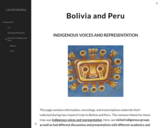
This page contains information, recordings, and transcriptions materials that I collected during two research trips to Bolivia and Peru. The common theme for these trips was Indigenous voices and representation. Here, I visited indigenous groups as well as had different discussions and presentations with different academics and social activist in these two countries. I hope that the information and materials here are helpful to everybody that visit this page. Click on the links below to access the materials per country.
If you use any of this information for a class, please feel free to share your lesson plan with me so that I can post it. In this way, other instructors/teachers/professors can also use these materials. The goal is to make all of these materials and lesson plans accessible.
Here are the recordings of the interviews, talks, and different explanation of some traditions and stories*, **. Each section is divided by subject as well as location.
The recordings are number for ease of access.
The transcripts for each recording can be found at the end of this page, inside the file folders.
*This data collection was possible thanks to the Fulbright Hays Group Abroad Projects (2016) funding with Oakton College.
**The sub-section of High Andes within the "Interviews and Talks" section was collected thanks to the LACC's US Department of Education Title VI Grant (2023) funding with FIU.
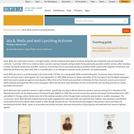
This collection uses primary sources to explore Ida B. Wells and anti-lynching activism. Digital Public Library of America Primary Source Sets are designed to help students develop their critical thinking skills and draw diverse material from libraries, archives, and museums across the United States. Each set includes an overview, ten to fifteen primary sources, links to related resources, and a teaching guide. These sets were created and reviewed by the teachers on the DPLA's Education Advisory Committee.